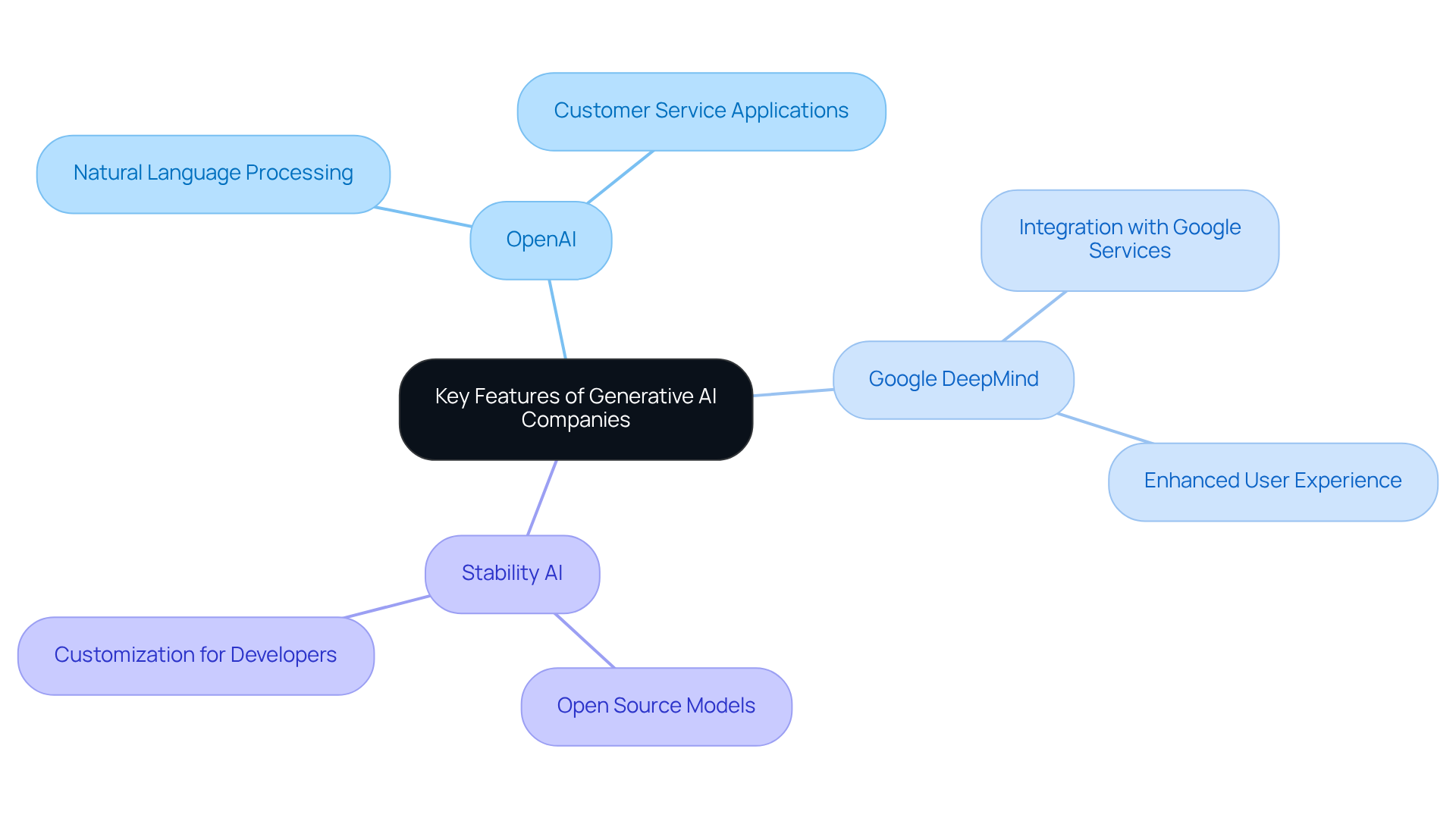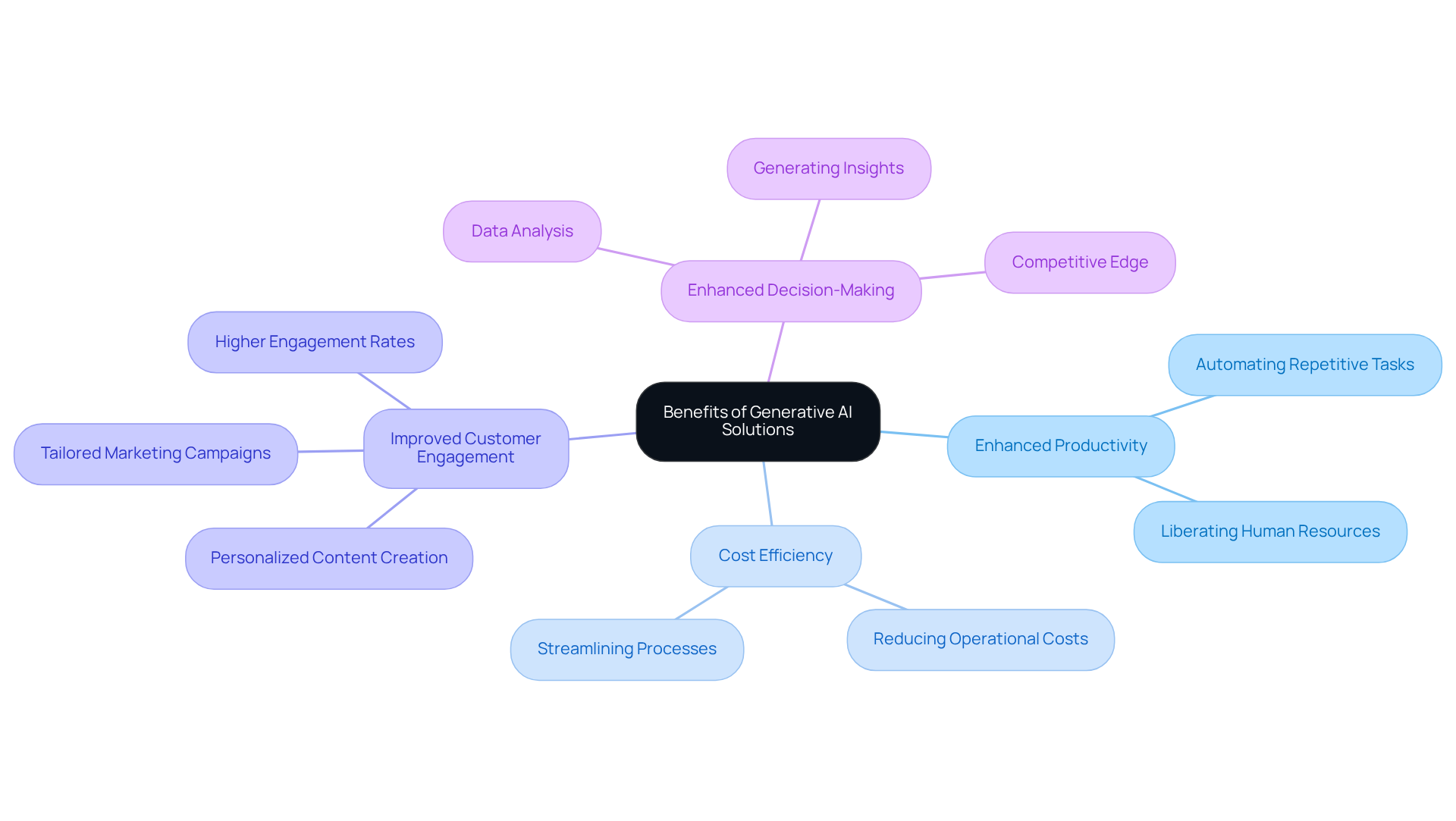AI
our blog
4 Key Insights on Generative AI Companies for CTOs

Overview
The article titled "4 Key Insights on Generative AI Companies for CTOs" delivers essential information that CTOs must grasp to navigate the evolving landscape of generative AI technologies and their business applications. It elucidates the fundamental concepts and technologies underpinning generative AI, evaluates the distinctive features of leading companies within this domain, and discusses the tangible benefits and real-world applications of generative AI solutions. By doing so, it equips CTOs with critical insights necessary for making informed strategic decisions.
Furthermore, this exploration of generative AI not only highlights the challenges faced by organizations but also presents actionable recommendations that can drive success in this innovative field.
Introduction
The rise of generative AI signifies a transformative shift in how businesses create and engage with content, utilizing advanced algorithms to emulate human creativity across various formats. For Chief Technology Officers (CTOs), grasping the intricacies of this technology is not merely advantageous; it is essential for navigating the competitive landscape.
As the capabilities of generative AI continue to evolve, so too do the challenges and opportunities associated with its adoption.
What insights can CTOs derive from leading generative AI companies to effectively leverage this technology for their strategic advantage?
Define Generative AI: Core Concepts and Technologies
Creative AI represents a pivotal category of artificial intelligence focused on the generation of novel content, encompassing text, images, audio, and various forms of information. This cutting-edge technology leverages sophisticated algorithms, particularly neural networks, to learn from existing data and produce outputs that closely resemble human creativity.
Key technologies integral to AI production include:
- Generative Adversarial Networks (GANs)
- Variational Autoencoders (VAEs)
- Transformer models such as GPT (Pre-trained Transformer for production)
These models, trained on extensive datasets, are capable of generating coherent and contextually relevant content in response to user prompts. For CTOs navigating the dynamic landscape of AI technologies, grasping these fundamental concepts is essential for harnessing their potential within business applications.

Analyze Key Features of Leading Generative AI Companies
Generative AI companies, including leading firms like OpenAI, Google DeepMind, and Stability AI, present distinct features that cater to various business needs.
- OpenAI's ChatGPT excels in natural language processing, enabling the generation of human-like text responses. This capability makes it particularly suitable for customer service applications, where effective communication is crucial.
- Google DeepMind focuses on integrating creative AI with existing Google services, enhancing user experience through seamless interactions.
- Conversely, Stability AI emphasizes open-source models, allowing developers to customize and implement AI solutions tailored to specific business requirements.
By analyzing these key features, CTOs can gain valuable insights into which company aligns best with their strategic goals and operational needs.

Evaluate Benefits of Generative AI Solutions for Businesses
Generative AI companies present a multitude of advantages for businesses, encompassing enhanced productivity, cost efficiency, and improved customer engagement. By automating repetitive tasks, creative AI liberates valuable human resources, enabling teams to focus on strategic initiatives.
Furthermore, these solutions facilitate the creation of personalized content at scale, thereby enriching customer experiences and driving higher engagement rates. For instance, generative AI companies that leverage this technology for marketing can develop tailored campaigns that resonate with specific audience segments, resulting in increased conversion rates.
Moreover, the ability to analyze vast amounts of data and generate insights significantly enhances decision-making processes, positioning organizations for a competitive edge.

Explore Use Cases: Real-World Applications of Generative AI
The remarkable versatility and effectiveness of generative AI companies is evident across various industries. In healthcare, for example, advanced AI analyzes patient data to create personalized treatment plans, significantly enhancing patient outcomes. Furthermore, in the entertainment sector, generative AI companies leverage artificial intelligence to produce scripts, music, and visual effects, streamlining the creative process and fostering innovation. In addition, in finance, generative AI companies play a critical role in fraud detection by analyzing transaction patterns and generating alerts for suspicious activities. These real-world applications not only highlight the technology's capabilities but also inspire CTOs to explore potential implementations within their own organizations.

Conclusion
Understanding the landscape of generative AI is essential for technology leaders who seek to harness its transformative potential. The insights presented in this article emphasize the necessity of grasping core concepts and technologies, such as Generative Adversarial Networks and Transformer models. By familiarizing themselves with these elements, CTOs can adeptly navigate the complexities of integrating generative AI into their business strategies.
This article has examined the distinctive features of leading generative AI companies, illustrating how OpenAI, Google DeepMind, and Stability AI address diverse business needs. Each organization possesses unique strengths, ranging from natural language processing capabilities to open-source solutions, equipping CTOs with valuable insights to align their technological choices with organizational objectives. Moreover, the advantages of generative AI, including enhanced productivity and improved customer engagement, highlight its potential to revolutionize business operations across various sectors.
As the applications of generative AI continue to broaden, it is imperative for CTOs to stay informed about current trends and real-world use cases. By embracing generative AI technologies, organizations can not only enhance efficiency but also stimulate innovation and growth. The call to action is unequivocal: explore these technologies, evaluate their relevance to your business, and leverage their capabilities to maintain a competitive edge in an ever-evolving digital landscape.









